|
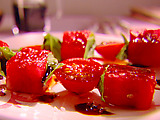
Tomato, Watermelon, and Basil Skewers
Recipe courtesy Giada De Laurentiis
Serves:
6 to 8 servings
Ingredients
* 1/4 cup balsamic vinegar
* 1/4 cup sugar
* 1 (4 to 5 pound) watermelon, cut into 32 (1 1/2-inch cubes
* 32 small basil leaves (or torn larger leaves)
* 16 cherry tomatoes, halved
* 2 tablespoons extra-virgin olive oil
* Kosher salt
* Special equipment: 16 (6-inch) skewers
Directions
Combine the balsamic vinegar and sugar in a small saucepan over medium heat. Bring to a simmer, stirring occasionally, until the sugar is dissolved. Turn off the heat and set aside to cool.
Starting with the watermelon squares, push the watermelon to the very tip of the skewer. Then skewer a basil leaf, then a tomato half. Continue with another watermelon, basil leaf, and tomato half. Place the skewer on a serving platter so it stands upright, using the lowest watermelon square as a base. Continue with the remaining skewers.
Drizzle the skewers with the reserved balsamic syrup and the olive oil. Sprinkle with coarse salt. Serve.
|
Margaret James
Lecture courtesy of Anne Dalke and Julia Lewis
Serves: anyone interested in the early experiences of Bryn Mawr College students or the James family history
Ingredients
• daughter of William and Alice James
• attended Miss Ingol’s School Cambridge and Miss Winsor’s School Boston, Mass
• 1906-08 attended Bryn Mawr College and majored in English and Philosophy
• 1912-13 volunteer at the Social Service Department of Massachusetts General Hospital
• 1917 married Mr. Bruce Porter and produced one son
Directions
This year Peggy began a serious, intense friendship with a student at Bryn Mawr named Marianne Moore. Peggy had occasional headaches like her mother's, she was prone to spells of depression, but she could also be vivacious and entertaining...."]
-William James
|
|

Arugula Salad and Ultimate Vinaigrette
Recipe courtesy Tyler Florence
Serves:
4 servings
Ingredients
* 1 shallot, finely minced
* 1 teaspoon Dijon mustard
* 2 teaspoons red wine vinegar
* 1/4 cup extra-virgin olive oil
* 1 teaspoon sugar
* 1 teaspoon honey
* Kosher salt and freshly ground black pepper
* 6 cups arugula
Directions
Combine the shallot, mustard, vinegar, oil, sugar, honey and salt and pepper in a jar and shake to emulsify.
Toss arugula with vinaigrette, to taste.
|
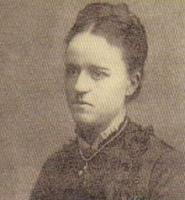
Alice James
Lecture courtesy of Anne Dalke
Serves: anyone interested in the early figures of feminism and mental illness or the James family history
Ingredients
• Susan Sontag, Alice in Bed: A Play in Eight Scenes (1992)
• The Diary of Alice James (1890-92)
• Excerpts: "A Woman in Conversation with Herself"
• Kristin Boudreau, "'A Barnum Monstrosity': Alice James and the Spectacle of Sympathy." American Literature, 65, 1 (March 1993): 53-67.
Directions
Combine an acerbic wit, brilliance, mental illness, feminism to yield...a diary? Good reads!
|
|
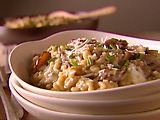
Gorgonzola and Porcini Mushroom Risotto
Recipe courtesy Giada De Laurentiis, 2008
Serves:
4 to 6 servings
Ingredients
* 4 cups low-sodium chicken stock
* 1 1/2 ounces dried porcini mushrooms
* 3 tablespoons butter
* 1 medium onion, diced
* 1 1/2 cups Arborio rice
* 1/2 cup dry white wine
* 1/2 cup grated Parmesan
* 3/4 cup (3 ounces) Gorgonzola, crumbled
* 1/4 cup chopped fresh chives
* 1/2 teaspoon kosher salt
* 1/4 teaspoon freshly ground black pepper
Directions
In a medium saucepan, bring the stock to a boil over medium-high heat. Add the porcini mushrooms. Remove the pan from the heat and set aside for 30 minutes until the mushrooms are tender. Using a slotted spoon, remove the mushrooms and set aside.
Reheat the stock to a simmer and keep warm over low heat.
In a large, heavy saucepan, melt 2 tablespoons of the butter over medium-high heat. Add the onion and mushrooms and cook until the onions are tender but not brown, about 3 minutes. Add the rice and stir to coat with the butter. Add the wine and simmer until the wine has almost evaporated, about 3 minutes. Add 1/2 cup of warm stock and stir until almost completely absorbed, about 2 minutes. Continue with remaining stock, adding 1/2 cup at a time, and allowing each addition to be absorbed, until the rice is tender to the bite and the mixture is creamy, about 20 to 25 minutes. Remove the pan from the heat. Stir in the Parmesan, Gorgonzola, chives, salt and pepper. Transfer the risotto to a serving bowl. Serve immediately!
|
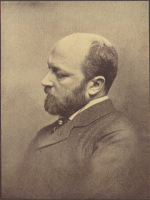
Henry James
Lecture courtesy of Anne Dalke
Serves: anyone interested psychology or philosophy or the James family history
Ingredients
Lecture courtesy of Anne Dalke
Serves: anyone interested in American novels or short stories or the James family history
Ingredients
• Henry James, "The Turn of the Screw" (1898)
• Oscar Cargill, "The Turn of the Screw and Alice James." PMLA 78, 3 (June 1963): 238-249.
• Shoshana Felman, "Writing and Madness (Literature/Philosophy/Psychoanalysis)," Yale French Studies 55-6 (1977): 94-113, 185-207.
• Henry James, “The Real Thing” (1892)
• Henry James, Preface and Chapters 1-14, The Portrait of a Lady (1881)
• Chapters 15-26, The Portrait of a Lady
• Chapters 27-42, The Portrait of a Lady
• Chapters 43-55, The Portrait of a Lady
• Cynthia Ozick, “The Lesson of the Master," Art and Ardor (1982) and
• "What Henry James Knew," What Henry James Knew and Other Essays on Writers (1993) [username and password required]
• Wai Chee Dimock, "Subjunctive Time: Henry James's Possible Wars." Narrative 17, 3 (October 2009): 242-254.
• Henry James, "The Question of Our Speech" (Bryn Mawr Commencement Address, 1905).
Directions
Start with a nineteenth-century realist, short story, and novel writer. Work well with hands until many texts are generated and end it as a modernist. "What was implicit in James became overt in Freud....In the fiction of realism--the Jamesian tale before the 1895 crux--knowledge is the measure of what can be rationally ascertained...the masterworks of modernism however, nearly always point to something far more subterranean...vibrate with cognitions that are ultimately not submissive to their creator. It is as if from that time forward, great ghost stories of the unconscious...the later James...is overridden by a strangeness that is beyond his capacity to domesticate or explicate."
|
|
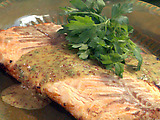
Grilled Salmon Fillet with Honey-Mustard Sauce
Recipe courtesy Bobby Flay, 2007
Serves:
4 servings
Ingredients
* 1/4 cup Dijon mustard
* 2 tablespoons whole-grain mustard
* 3 tablespoons honey
* 2 tablespoons prepared horseradish, drained
* 2 tablespoons finely chopped fresh mint leaves
* Kosher salt and freshly ground black pepper
* 2 pound fillet salmon, skin on
* 2 tablespoons canola oil
* 1 bunch watercress, coarsely chopped
* 1 small red onion, halved and thinly sliced
* 2 tablespoons aged sherry vinegar
* 2 tablespoons extra-virgin olive oil
Directions
Whisk together the mustards, honey, horseradish, mint and 1/4 teaspoon of salt and 1/4 teaspoon of pepper in a small bowl. Let sit for at least 15 minutes before using. Can be made 1 day in advance and refrigerated but do not add the mint until just before using. Bring to room temperature before using.
Heat the grill to high.
Brush the salmon with the oil and season with salt and pepper. Place the salmon on the grill, skin side down, and grill until golden brown and slightly charred, about 3 minutes.
While the salmon is cooking, place the watercress and onion in a medium bowl, add the vinegar and oil and salt and pepper and toss to combine. Transfer the salad to a platter, top with the salmon fillet and drizzle each fillet with the mustard sauce.
|
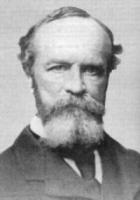
William James
Lecture courtesy of Anne Dalke
Serves: anyone interested psychology or philosophy or the James family history
Ingredients
(Most the remaining readings are to be found in The Writings of William James: A Comprehensive Edition. Ed. John J. McDermott. Chicago: the University of Chicago Press, 1977.)
• From The Principles of Psychology (1890) and Psychology: Briefer Course (1892)
• "The Stream of Thought," rpt. Comprehensive Edition, 21-74.Eugene Taylor.
• "Biological Consciousness and the Experience of the Transcendent: William James and American Functional Psychology." Rpt.
• Robert Wozniak, "Mind and Body: Rene Déscartes to William James." Bryn Mawr College, Serendip 1995.
• "Habit," rpt. Comprehensive Edition, 9-21.
• Anne Dalke. Weeding, Seeding and Place-Keeping: A Story with Three Steps and a Coda. Bryn Mawr College, Serendip. June 2007.
• From The Will to Believe and Other Essays in Popular Philosophy (1897)
• "The Will to Believe," rpt. Comprehensive Edition, 717-735.
• From the University Chronicle (Berkeley, California, 1898)
• "Philosophical Conceptions and Practical Results," rpt. Comprehensive Edition, 345-362
• From The Varieties of Religious Experience (1902)
• "Conclusions" and Postscript," rpt. Comprehensive Edition, 758-786.
• "The Ph.D. Octopus" (The Harvard Monthly, 1903).
• "Hegel and his Method"; rpt. Comprehensive Edition, 512-529.
• Gertrude Stein, "Objects." Tender Buttons. 1914; rpt. on-line by Bartleby.com
• Dana Cairns Watson, "Modifying the Mind: William James and Tender Buttons." Gertrude Stein and the Essence of What Happens. Nashville: Vanderbilt University Press, 2005.
• Jacques Barzun, Prologue and "The Genius." A Stroll with William James. New York: Harper and Row, 1983. 1-5, 262-302; available @ /~adalke/jamesfam/Barzun.pdf
• Louis Menand, “The Man of Two Minds,” “Brazil,” “Pragmatisms” and “Epilogue.” The Metaphysical Club: A Story of Ideas in America. New York: Farrar, Straus and Giroux, 2001. 73-95, 140-148, 351-375, 435-442; available @ /~adalke/jamesfam/Menand.pdf
• William James, "The Gospel of Relaxation" (Address delivered at Bryn Mawr, 1907).
Directions
In a large bowl mix together the following: a scientist, doctor and empirical, laboratory-based, experimental physiologist and psychologist, he was a major force in developing the modern concept of consciousness, at same time Freud was developing that of the unconscious; he was particularly interested in the relation between mental and bodily states. He was one of the great figures in the philosophical movement called pragmatism, which held that the truth of an idea is the sum of its actual results (he was interested in"the fruits, not the roots," of ideas). He was the author of the founding text of the modern study of religion, The Varieties of Religious Experience ("King James"), which locates religious authority in individual religious experience.
|
|
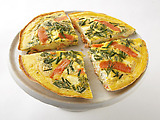
Smoked Salmon and Cream Cheese Frittata
From Food Network Kitchens
Serves:
4 to 6 servings
Ingredients
* 6 large eggs
* 2 tablespoons milk
* 1 tablespoon chopped fresh dill
* 1 teaspoon kosher salt
* Freshly ground black pepper, to taste
* 2 tablespoons chopped chives
* 2 ounces cream cheese, softened
* 2 ounces smoked salmon, chopped
* 2 teaspoons extra-virgin olive oil
Directions
Position a rack in the center of the oven and preheat to 375 degrees F.
Whisk the eggs, milk, dill, salt, pepper, and chives together in a bowl. Using two spoons or your fingers, separate the cream cheese into small clumps. Fold the cream cheese and salmon into the egg mixture.
Heat the oil in a medium non-stick skillet over medium-low heat. Pour the egg mixture into the skillet, and stir lightly to make sure the fillings are evenly arranged in the pan. Cook until the bottom is set, but not brown, about 2 minutes. Transfer the skillet to the oven and bake until the top is set, about 8 minutes. Remove from the oven, cover, and set aside for 5 minutes.
Invert the frittata onto a large plate. Cut into wedges and serve warm or at room temperature.
Copyright 2002 Television Food Network, G.P. All rights reserved
|

William James
Lecture courtesy of Paul Jefferson
Serves: anyone interested in the intellectual history of William James' theories
Ingredients
• "The Ph.D. Octopus" (The Harvard Monthly, 1903).
• Charles S. Peirce, "The Fixation of Belief." Popular Science Monthly 12 (November 1877): 1-15-- in cf. w/ "The Will to Believe"
• From Pragmatism: A New Name for Some Old Ways of Thinking (1907)
• William James, "What Pragmatism Means," rpt. Comprehensive Edition, 376-390; in cf. w/
• "Philosophical Conceptions and Practical Results," rpt. Comprehensive Edition, 345-362
• Charles S. Peirce, "How to Make Our Ideas Clear." Popular Science Monthly 12 (January 1878): 286-302.
Directions
View William from a distance, his ideas are relevant only when incorporated into the intellectual history of his time. Place particular emphasis on isolating and translating the similar terms that he and the earlier pragmatist C. S. Peirce use in their writing.
|
|
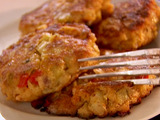
Salmon Cakes
2008, Ina Garten, All Rights Reserved
Serves:
5 servings
Ingredients
* 1/2 pound fresh salmon
* Good olive oil
* Kosher salt and freshly ground black pepper
* 4 tablespoons unsalted butter
* 3/4 cup small-diced red onion (1 small onion)
* 1 1/2 cups small-diced celery (4 stalks)
* 1/2 cup small-diced red bell pepper (1 small pepper)
* 1/2 cup small-diced yellow bell pepper (1 small pepper)
* 1/4 cup minced fresh flat-leaf parsley
* 1 tablespoon capers, drained
* 1/4 teaspoon hot sauce (recommended: Tabasco)
* 1/2 teaspoon Worcestershire sauce
* 1 1/2 teaspoons crab boil seasoning (recommended: Old Bay)
* 3 slices stale bread, crusts removed
* 1/2 cup good mayonnaise
* 2 teaspoons Dijon mustard
* 2 extra-large eggs, lightly beaten
Directions
Preheat the oven to 350 degrees F.
Place the salmon on a sheet pan, skin side down. Brush with olive oil and sprinkle with salt and pepper. Roast for 15 to 20 minutes, until just cooked. Remove from the oven and cover tightly with aluminum foil. Allow to rest for 10 minutes and refrigerate until cold.
Meanwhile, place 2 tablespoons of the butter, 2 tablespoons olive oil, the onion, celery, red and yellow bell peppers, parsley, capers, hot sauce, Worcestershire sauce, crab boil seasoning, 1/2 teaspoon salt, and 1/2 teaspoon pepper in a large saute pan over medium-low heat and cook until the vegetables are soft, approximately 15 to 20 minutes. Cool to room temperature.
Break the bread slices in pieces and process the bread in a food processor fitted with a steel blade. You should have about 1 cup of bread crumbs. Place the bread crumbs on a sheet pan and toast in the oven for 5 minutes until lightly browned, tossing occasionally.
Flake the chilled salmon into a large bowl. Add the bread crumbs, mayonnaise, mustard, and eggs. Add the vegetable mixture and mix well. Cover and chill in the refrigerator for 30 minutes. Shape into 10 (2 1/2 to 3-ounce) cakes.
Heat the remaining 2 tablespoons butter and 2 tablespoons olive oil in a large saute pan over medium heat. In batches, add the salmon cakes and fry for 3 to 4 minutes on each side, until browned. Drain on paper towels; keep them warm in a preheated 250 degree F oven and serve hot.
|

William James
Lecture courtesy of Bharath Vallabha
Serves: anyone interested psychology or philosophy or the James family history
Ingredients
• From A Pluralistic Universe (1909) "The Types of Philosophic Thinking"; rpt. Comprehensive Edition, 482-496.
Directions
Distill William's theories down to their essential oil. Then, one-by-one stir in elements from one's own life. Cease these additions when a satisfyingly strong consistency is achieved.
|
|
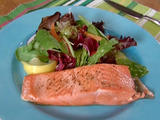
Coho Salmon Fillets
Recipe courtesy Alton Brown, 2009
Serves:
2 servings
Ingredients
* 2 (6-ounce) coho salmon fillets, 1 1/8 to 1 1/4 inches thick, pin bones removed
* 2 teaspoons vegetable oil
* 1/4 teaspoon kosher salt
* Freshly ground black pepper
Directions
Set a 10-inch nonstick saute pan over medium heat. Brush each fillet with the oil and sprinkle with kosher salt and black pepper. Place the fillets in the pan flesh side down. Cook for 2 minutes. Turn each fillet over and continue to cook for another 2 minutes. Transfer the fillets to a plate, cover loosely with foil, and allow to rest for 5 minutes before serving.
|

William James
Lecture courtesy of Paul Grobstein
Serves: anyone interested in a simplified account of psychology or philosophy
Ingredients
• 3 diary entries (February, April, 1870), rpt. Comprehensive Edition, 6-8.
• Paths to Storytelling as Life: Fellow-Traveling with Richard Rorty
Directions
Carefully clean William's writing of all philosophical terminology. Be sure to remove truth and discard. Then clarify habit, will, believe, and will to believe as one would butter. Combine clarified mixture with "the pit of insecurity beneath the surface of life." Enjoy!
|
|

Cheese Plate
Julia Lewis 2010
Ingredients
* Saint Marcellin
* Coupole
* Bijou
* Camembert
* Comte Fort des Rousses
* Bra Tenero
* Mahon
* Pecorino Stagionato
* Piave
* Monte Enebro
* Valdeon
Directions
Cut cheeses to allow 3oz per diner. Place cheeses in a circular pattern on a large serving plate. Add your choice of vehicle for consuming the cheese: bread, crackers, fruit, etc…
*Cheese plate can be served as a dessert in the European style or as a second appetizer in the American style
|
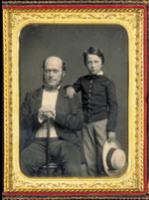
Henry James Senior
Lecture courtesy of Anne Dalke
Serves: anyone interested the James family history
Ingredients
• A large inheritance resulting in financial independence
• intellectual ambitions and shifting moods
• "vastation" that came upon him suddenly, without preparation; it presented itself to him visually, viscerally, as "some damned shape squatting invisible to me within the precincts of the room"
• the teachings of the 18th c. theologian Emanuel Swedenborg in understanding this experience as a necessary "emptying out," a stage in a redemptive spiritual process
Directions
Consider the effects of an eccentric father on a brood of sensitive and talented children... How did a rogue intellectual give life to 3 famous children?
|













